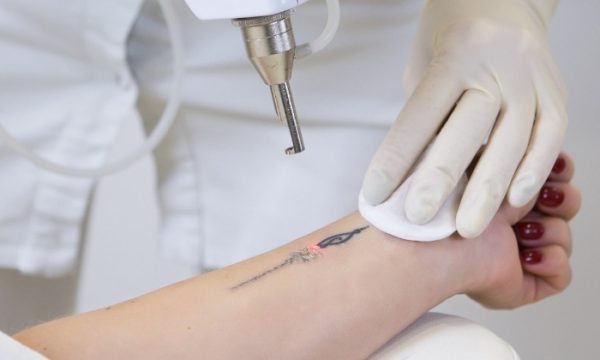ABOUT LASER TATTOO REMOVAL
Laser tattoo removal involves using high-intensity beams of light to break down the pigmentation of ink to remove unwanted tattoos. The lasers have different wavelengths, which are absorbed by the different colors of ink and break down the pigment.
Using laser therapy for tattoo removal has fewer associated risks when compared with older methods of tattoo removal such as excision. Laser removal is most effective on black or blue ink. Colored tattoo removal requires more sessions and is more difficult to remove.
The number of sessions needed varies with each patient and is dependent on the type of tattoo ink that is being removed, the size of the tattoo, the location, and on the color of the patient’s skin. With each session, different lasers may be used. Some patients may require 2-4 sessions, whereas others may require 10 sessions or more.
Recommended for
- Removing unwanted tattoos
TIME REQUIREMENTS
- Number of days in hospital: 1.
Patients can leave after the treatment however, will need to return for subsequent sessions.
- Average length of stay abroad: 2 days.
Patients can leave after the treatment, however regular sessions are required, often 7 weeks between each session to allow the area to heal.

COMPARE LASER TATTOO REMOVAL PRICES AROUND THE WORLD
HOW TO FIND QUALITY TREATMENT ABROAD
BEFORE LASER TATTOO REMOVAL ABROAD
The patient will meet with the dermatologist or doctor to discuss the number of sessions that will be needed to remove the tattoo.
Before the treatment begins, some patients may be given a topical anesthesia or local injection to help prevent pain, however this varies with each patient. Often the treatment is done without anesthesia.
The dermatologist or doctor may perform a small patch test at first, to test the skin’s reaction to the laser.
HOW IS IT PERFORMED
A laser is placed against the skin which gives off pulses light, breaking down the ink of the tattoo. The intensity of the light varies, depending on the tattoo.
The procedure can be quite painful for some, and the sensation has been compared to having many small electric shocks or having rubber bands snapped against the skin.
Multiple sessions may be required, varying with each tattoo. After each session, the tattoo will fade and become less visible. Not all tattoos can be fully removed and some traces of the tattoo may remain.
Anesthesia
Topical anesthetic or local injection.

WHAT TO EXPECT AFTER LASER TATTOO REMOVAL
Post procedure care
Ice is usually applied to the area after treatment to help prevent swelling. The area of treatment is bandaged and the patient is given an ointment or cream to apply to the area.
Possible discomfort
The procedure can be painful and some patients may be given a topical anesthetic or local injection to ease the pain.
IMPORTANT THINGS TO KNOW ABOUT LASER TATTOO REMOVAL
Potential risks
- Infection
- Scarring
- Blisters
- Swelling
- Bleeding
- Hypopigmentation (treated area becomes lighter than surrounding skin)
- Hyperpigmentation (treated area becomes darker than surrounding skin)
FREQUENTLY ASKED QUESTIONS
Some patients describe the sensation as having a hot rubber band snapped on the skin. Most patients say that the pain is bearable, but worse than getting the tattoo in the first place. During different parts of the procedure, the laser’s power will be turned up and down, with higher power being more painful. There are different techniques used to remove tattoos with laser technology and some may be more painful than others.
To control pain during the procedure, the doctor may apply a numbing cream and/or use a local anesthetic, which numbs the affected area.
Most patients are happy with the results of laser tattoo removal, although it may take several treatments before they are fully satisfied. There are many factors that affect the overall results from laser tattoo removal, including skin complexion, how old the tattoo is, and the colors and inks used in the tattoo. A consultation with an experienced professional can give you an accurate prognosis for treatment and help you set realistic expectations.
After treatment, most patients are left with some level of scarring at the treatment site. Further treatments, some also involving lasers, can reduce the appearance of these scars as well. The scarring is generally much lighter and less noticeable than the tattoo.
There are no major risks associated with laser tattoo removal. The most common complication following treatment is scarring at the treatment site, which is usually light. Other possible complications include infection and skin discoloration.
Laser tattoo removal is possible on skin of a dark complexion. Before the procedure, the laser is calibrated to a proper setting for your skin type.
It is impossible to reasonably predict how many treatments any tattoo will need. Darker tattoos or ones with lots of shading may require more treatments than smaller, lighter tattoos. Tattoos with colored ink (as opposed to plain black) may require more sessions. During your consultation, the doctor can likely give you an estimate.












